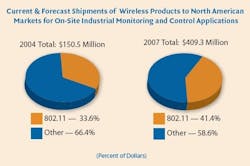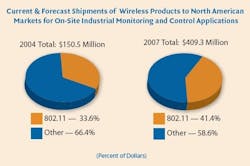802.11 networks will exceed 900 MHz by 2007
The study’s data reveals that proprietary protocols operating in the 900 MHz band accounted for the largest share of shipments in 2004, followed by IEEE 802.11b. The two networks combined to account for just over half of shipments, and are expected to combine for a similar share in 2007, but with IEEE 802.11b gaining ground. Similar gains in share are also expected for IEEE 802.11a and IEEE 802.11g. Most of these gains will be at the expense of products using proprietary protocols in ISM bands.
VDC concludes that the primary reasons for this shift include:
- Lower prices of IEEE 802.11 products compared to most proprietary networks;
- Standardization of office and plant floor networks;
- Multiple vendor options;
- High-data throughput; and
- Brand-name familiarity from IT personnel
Despite the apparent advantages of IEEE 802.11, proprietary networks often are preferred in industrial applications that need longer transmission distances with moderate bandwidth requirements. In addition, the study finds the perception that these products provide higher reliability and security.
"The choice between standardized networks, like 802.11 and proprietary protocols, is largely based on the application requirements," says VDC analyst Jake Millette. "802.11 is especially useful in applications with shorter transmission distances and high data-rate requirements, whereas a proprietary protocol operating in lower frequencies can transmit longer distances and through more obstacles, albeit more slowly. Proprietary networks will continue to be used in many applications." However, because of the advantages of each in different applications, Millette says, many wireless suppliers are expanding their product lines to include both standard and proprietary networks.
Source: Venture Development Corp.


